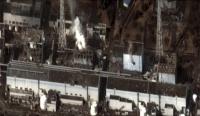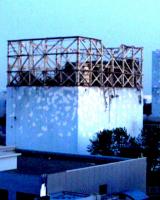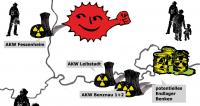A gigantic earthquake and subsequent tsunami struck Japan on 11 March.
Thousands of people were buried under buildings or died in the flooding. In
many of Japan's more than 50 nuclear reactors cooling systems broke down.
This caused several hydrogen explosions and at least partial fuel rod
meltdowns in the reactor blocks one to four of the Fukushima Daiichi nuke.
Chapters: News and impacts in Japan | Debate and protest in Germany | independent media | linksunten reports | mainstream press | Events | Demos Monday 14.03. 6 p.m. everywhere
linksunten initiatives: BloXberg | Anti-Atom-Plenum FR | Anti-Atom-Gruppe KA | Neckarwestheim Anti-Atom | Anti-Atom-Ini Dreyeckland | TRAS | Stop-Fessenheim | BUND Freiburg | menschenstrom.ch
Cross-regional initiatives: Ausgestrahlt | BUND | Robin-Wood | BI Luechow-Dannenberg | Greenpeace | Sortir du Nucléaire | X-Tausendmal-Quer | Bäuerliche Notgemeinschaft | Bure-Stop | SOFA Münster | Lubmin Nix-Da
Impacts of the disaster in the western Pacific
The 11 March earthquake, subsequent quakes and flooding waves severely
damaged several atomic installations in Japan. Inter alia an explosion on
Saturday destroyed the building of reactor block I of the nuclear power
station "Fukushima daiichi genshiryoku hatsudensho" where fuel rods are
melting down. On Monday there was a second hydrogen explosion in reactor
block III which uses plutonium as well as uranium. It also emerged on Monday
that the fuel rods in block II are completely dry and exposed. The necessary
cooling is not working in at least four more of the more than 50 reactors in
Japan.
Update 15.03. 1:00: Another explosion (this time in block 2) damaged not
only the outer reactor building but also the pressure container. At times
the wind turned towards Tokyo.
Update 15.03. 14:30: In the cooling basin of Block IV fire broke out, radioactivity got into the atmosphere. High radiation levels are measured, personnel were evacuated from the control room. Cooling in Blocks V and VI is not working properly.
Update 16.03 9:45: After another fire in block IV, ongoing damage in block III and rising radiation the remaining 50 workers were temporarily withdrawn from Fukushima. The military tries to cool the reactor with helicopters.
Update 16.03 15:00: The helicopters could not cool the damaged reactorblocks because of high radiation. Now police water-canons will try to cool them.
Update 17.03 9:00: During the last hours helicopters
and police water-canons tried again to cool the reactor. Tepco is
working on reestablishing the electricity-supply. US-army drones try to
photograph the reactor.
The evacuation radius around the first accident reactor was extended to 20
kilometres on Sunday. Media and government are trying to downplay the
seriousness of the situation. Reliable information about no longer deniable
happenings is being gathered by the IAEA. Independent nuclear experts no
longer doubt that the situation is close to the worst expectable, that is,
almost totally out of control. Attempts are being made to fill reactor
blocks I - IV with sea water to prevent further overheating. Experts say
this emergency measure is "not provided for in this form in any manual" and
renders the reactors permanently unusable. The contaminated water turns into
steam or runs back untreated into the sea.
The western Pacific death toll from the Strength 9 Richter scale earthquake
has already reached 10,000. Thousands of people are still missing. More than
200,000 have been evacuated from the Fukushima area. Millions in northern
Japan were still without power and water.
Debate and demonstrations in Germany
Nukes have also been built in potential earthquake areas elsewhere, for
example the scrap reactor in Fessenheim, France. It is also important to
note that it was not the earthquake and tsunamis as such that put the
Japanese reactors out of control, but in the final analysis it was the
failure of the power supply. Even in areas not vulnerable to earthquakes,
power failure is a crucial nuclear vulnerability.
The catastrophe is again mobilising tens of thousands of opponents of the
high-risk atomic technology. On 14 March more than 100,000 people took to
German streets [1,2,3] demanding that all nukes be switched off immediately.
Activists chained themselves on at the Biblis plant. On 12 March about
60,000 demonstrated between Stuttgart and Neckarwestheim, while the Social
Democratic Party and The Greens, despite their atomic nonsense, yet again
pretended to themselves that they are anti-nuclear parties.
For election-tactical reasons the CDU-FDP (conservative-liberal) coalition government wants to suspend for three months the extension of nuke running times and offers as a sacrifice the final closure of Neckarwestheim I, and closure for three months of six other nukes built before 1980 as well as Krümmel, which has been out of action for years because of endless mishaps, intending to keep using what it calls the "bridging technology". Switzerland is putting a moratorium on construction of new nuclear power plants.
- IndyBay: Political Debate Unleashed in California by Devastation in Japan
- IndyDC: Tokyo Electric to Build US Nuclear Plants: The No BS Info on Japan's Disastrous Nuclear Operators
- DemocracyNow! - A daily TV/radio news program in the United States.
- Freie-Radios.net - Free Radio Exchange Plattform for German Speaking Radios
- de.indymedia.org/castor/ - Anti-Atom-Berichte bei IMC Deutschland [mostly german]
Reports at linksunten.indymedia.org:
- Germany temporarily switching off seven nukes, may rescind longer running times
- AKW Biblis: Ankettaktion
- Köln: Weit über 2000 Menschen auf "Atomkraft? Es reicht! Atomanlagen weltweit sofort abschalten!" Kundgebung + Spontandemo
- BI Umweltschutz kritisiert "Moratorium", Mahnwachen in Dannenberg und Lüchow
- Die atomare Bedrohung: Von Fukushima (J) nach Fessenheim (F)
- Atomkraft jetzt abschalten – den nuklearen Wahnsinn stoppen!
- Atomausstieg selber machen! Betriebsblockade des AKW Neckarwestheim!
- Protest in Gorleben - BI Umweltschutz fordert Konsequenzen der Reaktorkatastrophe
- "Atomkraft? Es reicht! Atomanlagen weltweit sofort abschalten!"
- Gorleben - Endlager-Schwarzbau kurz besetzt
- "Schaltet die Reaktoren endlich ab!"
- German protest in empathy with Japanese nuclear disasters
- Spiegel-Online Liveticker | Overview of articles (German Newsmagazin)
- Frankfurter Rundschau Liveticker | Overview of articles (German Newspaper)
- Tagesschau des Schweizer Fernsehens (Swiss television News)
- Guardian (British Newspaper)
- NHK (English page of the Japanese TV broadcaster)
- Al Jazeera English: Live Stream
- BBC: Live Stream
- Kyodo (Japanese news agency, English)
- Tagesschau-Ticker (German television News)
- taz on the situation in the Japanese nukes (German Newspaper)
Meetingpoints for demonstrations // Talks // etc.
- Anti-Atom-Vollversammlung Mittwoch, 16. März 2011 - 19:00 Monoplex-Kino in der Regenbogenfabrik Berlin
- (FR) Offenes Plenum: Atomausstieg selber planen! Donnerstag, 17. März 2011 - 19:00 KTS Freiburg
- Vortrag: Atomkraft im nationalen Energiemix - Eine Waffe in der imperialistischen Staatenkonkurrenz Donnerstag, 17. März 2011 - 19:30 - 22:30 Planwirtschaft Karlsruhe
- Aufruf: Demo für den sofortigen Ausstieg aus der Atomkraft Samstag, 19. März 2011 - 14:00 Uhr Neumarkt Köln
- Demo gegen Atomkraft Sonntag, 20.03.2011 - 14:00 AKW Biblis
-
Trinationale Demo: Fessenheim? Abschalten! Sonntag, 20.03.2011 - 14:00 Neuenburg
- Alle Atomkraftwerke abschalten – sofort! Sonntag, 20.03.2011 - 15:00 AKW Neckarwestheim
- Es wird für nächsten Montag, 21.3.2011, erneut zu dezentralen Demos aufgerufen.
(wenn ihr noch von weiteren Terminen wisst, schreibt einen Kommentar)
Meetingpoints for Demos Monday 14.03. 6 p.m. everywhere
- Augsburg Rathausplatz
- Bensheim Mittelbrücke
- Biberach (Riss) Marktplatz (17:30)
- Biblis vor dem AKW Bericht
- Darmstadt Luisenplatz (17:00)
- Ehingen (Donau) Marktplatz
- Emmendingen Marktplatz
- Frankfurt (Main) Katharinenkirche (17:00)
- Freiburg Bertoldsbrunnen
- Fürth (Odenw) an der alten post
- Heidelberg Bismarckplatz
- Heilbronn Kliliansplatz
- Ingolstadt Kreuzung am Stein/Ludwigstraße
- Kaiserslautern Kerststraße/ Marktstraße (17:30)
- Karlsruhe Marktplatz (17:30)
- Ketsch Bahnhofsanlage
- Kircheim unter Teck Rathaus
- Köln Rudolfplatz Bericht
- Konstanz Markstätte am Brunnen
- Lörrach Postplatz
- Magdeburg Alter Markt/vor McDonald's
- Mannheim Paradeplatz
- Mosbach Kirchplatz
- Mühlacker Bahnhofstraße
- Neustadt/Weinstraße Marktplatz
- Nußloch Lindenplatz
- Offenburg Rathaus (17:30)
- Pforzheim Marktplatz
- Phillipsburg bei den gelben "Atommüll"-Fässern am "Penny"-Kreisel
- Rottweil Schwarzen Tor
- Schwäbisch Gemünd Johannisplatz
- Schopfheim Marktplatz
- Stuttgart Schlossplatz
- Tübingen Holzmarkt
- Tuttlingen Marktplatz
- Ulm Münster
- Waldkirch Bahnhof und/oder Marktplatz
- Waldshut-Tiengen Rathaus
- Weinheim Fußgängerzone "Reiterin"
Weitere Treffpunkte findet ihr bei .ausgestrahlt.
(wenn ihr noch von weiteren geplanten Demonstrationen wisst, schreibt einen Kommentar)





